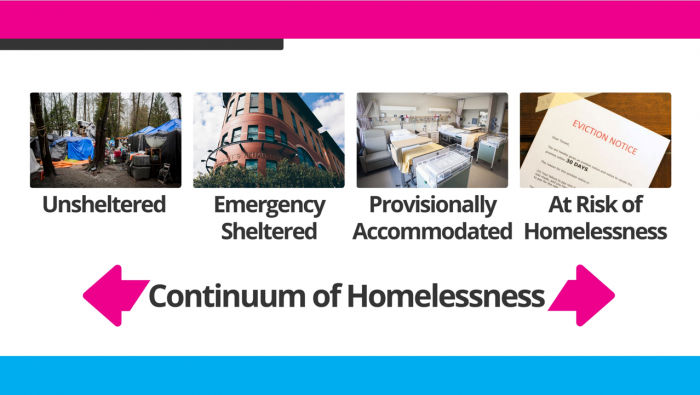World Homeless Day 2021
October 8, 2021

The Calgary Drop-In Centre (the DI) is proud to stand alongside our peers in the homeless-serving sector in recognizing World Homeless Day, a day that has been commemorated on October 10 since 2010. The idea behind World Homeless Day, per their website, is to draw attention to those experiencing homelessness in local communities worldwide and provide opportunities to get involved.
This year, the DI is choosing to focus on education surrounding the spectrum of homelessness. Often, the perception around experiencing homelessness is one of “sleeping outside” or “staying in shelter” or “not having access to food and water” among other stereotypical portrayals. The reality is that experiencing homelessness is complex, and there’s not a “one size fits all” explanation of what homelessness is and why people experience it. Homelessness is a point in time in a person’s life, similar to unemployment, and it doesn’t define an individual.
We often think of homelessness as a spectrum.

On one side of the spectrum, we have what’s called “unsheltered,” which may also be referred to as “rough sleeping.” This refers to people who are sleeping outside. In Calgary, we typically see this in inner-city, in parks, by the river, or on benches. There are multiple outreach teams in our city who support this population, such as the DOAP Team or Be the Change YYC.
Often, folks will come into shelter if it’s really hot or cold outside or if they need some supplies.
People have their own reasons to sleep outside, and sometimes that reason is to maintain their independence the best they know how to.
Next on the spectrum are those who are in emergency shelters, like the DI. In Calgary, there are several emergency shelters that are temporary places to sleep, eat, and access the necessary supports to find the most stable and independent living possible.
In most shelters, people sleep temporarily on mats or bunk beds and have access to meals, showers, washrooms, and other essential services.
Shelters like the DI see a lot of people experiencing homelessness for long periods of time. Some shelters have housing programs built into the shelter so they can help people find a home that meets their needs. It’s important to remember that these shelters are part of the process, and that when someone is experiencing homelessness, their journey will be unique and reflect what they need.
Moving further along the spectrum, you can begin to see experiences of homelessness that aren’t as commonly thought of but are equally important to be aware of.
The third category of homelessness is known as Provisionally or Temporarily Accommodated. This refers to folks who do not have their own fixed address and are couch surfing, temporarily staying with friends or family, or are staying in shelter or jail without a home to return to. Though their experiences differ to those who are unsheltered or utilizing emergency shelters – likely due to social supports or friends and family – it is important to recognize their experiences lest they fall through the cracks to a more vulnerable state.
Finally on the spectrum are those at risk of experiencing homelessness. Most people in poverty are at risk of losing their housing, particularly those without social supports like family or friends who could offer financial or other kinds of help.
Studies had shown that before the pandemic, nearly half of all Canadians were living paycheque to paycheque – or one unexpected expense away from serious trouble. Combined with the financial difficulties the pandemic has brought, the risk of homelessness is an issue that needs the proper attention and support for Canadians to avoid moving further along the spectrum.
That is why this year for World Homeless Day, on top of the existing efforts the DI takes as a housing-focused emergency shelter, we are asking Calgarians to take a moment to familiarize themselves with the spectrum of homelessness, and to realize that anyone could experience a series of events that might lead to homelessness.
With the proper supports in place and a little bit of kindness, it is our goal to help reduce the stigma of homelessness through educational efforts like these, and to ensure we can identify the risks of homelessness to ensure that everyone has and can keep their own place to call home.
Click here to support the DI todayRecent Posts
June 19, 2025
February 19, 2025




